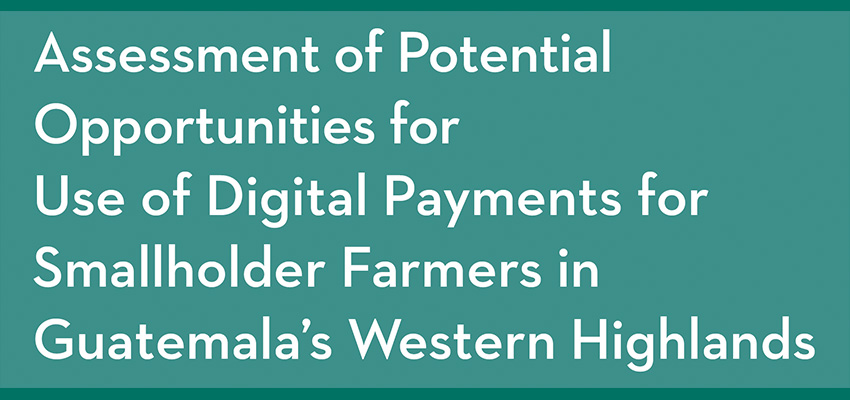
This research project, carried out in collaboration with the USAID’s Feed the Future Program, explored 1) how digital financial services (DFS) could help address the unmet financial needs of smallholder farmers (SHFs); 2) the conditions under which SHFs adopt DFS to meet these needs; and 3) how different stakeholders perceive farmer needs, DFS availability, and incentives and barriers to DFS Guatemala.
Excerpt: Conclusions and Recommendations
Through the research, the team identified several key findings for Guatemala and specific recommendations. This section outlines the findings, recommendations, and the stakeholders who could potentially implement these recommendations.
First, financial decisions are often made in collaboration with other members of the household. Sixty-six percent of SHFs indicate that they make decisions together. It is important for providers and enablers to consider the needs and preferences of men and women, as well as the household unit. Thus, it is necessary to understand the local context and household dynamics before beginning to pilot a product or service. In the co-design workshop, one of the teams discussed the opportunity to create a family credit record that makes it easier for a family to access financial services as a unit.
The study also discovered that the comfort level of farmers at banks often varies by ethnicity; indigenous populations felt less comfortable in banks compared to mixed or Ladino groups. Providers, enablers, and conveners could consider addressing this challenge with sensitivity training and alternative delivery/service options aimed at reducing bias towards farmers with an
indigenous background.
The research also found that financial inclusion is less prevalent than digital inclusion in Guatemala, which demonstrates that mobile phone penetration is not necessarily associated with an uptake of DFS. Providers, enablers, and conveners need to know that although access to a mobile phone may remove technical barriers to engaging with DFS, they must also articulate a clear value proposition for farmers and establish trust. In Guatemala, if farmers have a previous relationship with an institution that they trust, then they are more likely to adopt DFS. Sixty-eight percent of DFS users had a previous relationship with their provider. Thus, providers and enablers need to generate mechanisms to develop relationships with farmers and build trust if they want to encourage the use of DFS. Two of the groups in the co-design workshop emphasized that there is a need to better understand the local context and distrust of financial institutions and DFS.
Once a relationship has been established with a service provider, farmers in Guatemala are more likely to adopt DFS quickly (in less than one month for 42% of customers and one week to one month for 32%). Thus, it is important that providers and enablers invest in relationships with farmers. Marketing and sales strategies targeting farmers can speed up the expansion of DFS usage in the country.
DFS participants often adopted DFS out of necessity. Fifty-five percent of DFS users indicated that they adopted DFS to pay a bill or service. Thus, if providers and enablers could collaborate with the private sector on DFS programs, then farmers may be more likely to use it.
Finally, in Guatemala, there was a disconnect between the perceptions that the providers, enablers, and conveners had of the farmers and the barriers to adoption. For the farmers, they were most concerned with trust and wanted better/cheaper financial services, whereas the supply-side actors perceived financial and/or digital knowledge to be the largest barrier. This issue was addressed in the co-design activities, as one team indicated the need for more research to better understand the needs, preferences, and barriers to adoption as well as working directly with farmers to generate relevant solutions.
This report provides an overview of the key findings. Although additional data are available, the results will be shared in subsequent publications. However, the initial research questions have been addressed in this report as well.
- Research question 1 (how can DFS address unmet financial needs of SHFs): the report highlights that digitizing purchases for agricultural inputs and payments for crops are likely the most useful for farmers in Guatemala. The report also shows that farmers are more likely to use DFS to pay a bill or service.
- Research question 2 (conditions for DFS adoption): this report demonstrates that trust is an important component for adoption DFS, farmers often adopt DFS out of necessity, additional education on the benefits of DFS may be required, and it may be beneficial to target households rather than individuals.
- Research question 3 (perception of farmer needs, DFS availability, and incentives and barriers to use by supply and demand side actors): the comparison of farmer expectations and preferences varied from the perceptions that the supply-side actors had about the farmers.
Through this work, additional questions arose:
- Why is there a misperception between farmers and supply-side actors related to farmer needs and capabilities? How might we address this issue?
- What are the farmers’ needs, behaviors, and preferences and how could there be greater alignment with what the farmers need and the services offered?
- What is the experience of current DFS clients and how could the providers improve that experience?
- What are the best strategies and interventions for developing trust between SHFs and financial institutions?

